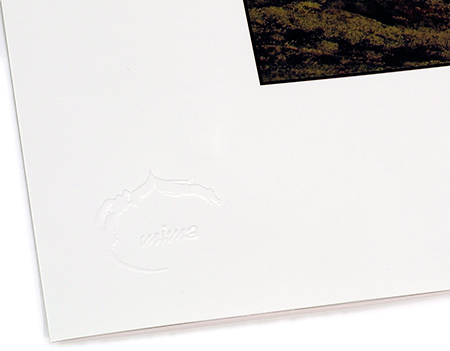PAPER: fine art rag / PHOTO
|
Fine Art Rag Paper
|
Artists have been painting on watercolour paper made in the traditional way from cotton rags for centuries, but the industry has gained a new lease of life by treating these beautiful papers with an invisible coating that is receptive to the pigment inks of digital printers. AKA 'giclée' prints, they offer incredible saturation, depth of color and sharpness, altogether a beautifully finished print that captures the essence of the artist’s intent. All six papers that we stock are acid free, available in smooth or textured finish, with and without optical brighteners. (Please refer to Stock Materials for full details.)
|
VIBRANCE LUSTER & GLOSS PHOTO PAPER
Vibrance heavy weight photo papers were developed for the discerning photographer who demands maximum color gamut, Dmax, and image resolution. Using a cockle-free RC base that gives the product a true photographic feel, Vibrance papers allow for maximum ink coverage and produce stunningly vivid images. At two thirds the price of the fine art papers, these can be an economical alternative for large scale projects, exhibitions etc. (Please refer to Stock Materials for full details.)
epson Metallic LUSTER Photo Paper
Designed with an incredible Dmax and rich color gamut, this semi-gloss, E surface, photographic paper features a unique metallic surface that provides extreme sharpness and depth. More expensive than the regular photo papers, it's priced the same as the fine art rag papers. Available up to 44" wide.
Borders
A wide border looks and feels more 'luxurious' for several reasons, number one being that to set your image off you want as much uninterrupted blank space between it and whatever is behind/around it as possible.
Another function of the border is to allow you to handle the print without touching the printed surface. The edge is the most vunerable part of a print so clearly the wider the better, and should any damage be sustained you can always trim down a border without compromising the print itself.
If your intention is to sell your prints as "fine art" then consideration has to be given to signing and editioning/numbering the prints. This is usually done within the border under the image and you don't want it to look cramped, so 1" is probably your absolute minimum. Remember it still has to have space around the edge for the mat to cover. A 2" (or greater) wide border is highly recommended for fine art prints..
Another function of the border is to allow you to handle the print without touching the printed surface. The edge is the most vunerable part of a print so clearly the wider the better, and should any damage be sustained you can always trim down a border without compromising the print itself.
If your intention is to sell your prints as "fine art" then consideration has to be given to signing and editioning/numbering the prints. This is usually done within the border under the image and you don't want it to look cramped, so 1" is probably your absolute minimum. Remember it still has to have space around the edge for the mat to cover. A 2" (or greater) wide border is highly recommended for fine art prints..
|
Related Article: Reproduction of a 'Deckle Edge' [Creative Use of a Paper Border]
|
working with standard sizes [when your images are not...]
|
Courtesy: Christina Stobbs, BC
|
Borders are provided to facilitate handling, matting and framing of the print.
They also provide a useful way to standardize your print sizes by accommodating images of different proportions, and standard sizes will streamline the marketing and selling of your prints... Left: 20"x 13.3" image (3:2) placed in a 24"x20" sheet of paper (6:5)
for standard exhibition frame or portfolio sleeve. |
HOW rag PAPER IS MADE
St.Cuthbert's Mill in England, manufacturers of Somerset Velvet, have been making paper for artists since the 1700's. This charming short film is well worth watching, enjoy!
paper presentation options
|
|
flush/float mountingWatercolour Rag Paper Mounted and Laminated onto Medium Density Fibre Board.
|
Framing Behind GlassPreservation/Conservation/Archival Framing is a method of picture framing that protects and preserves artwork.
|
some examples of our work
|
|










